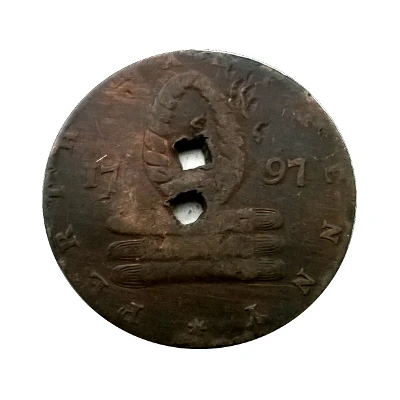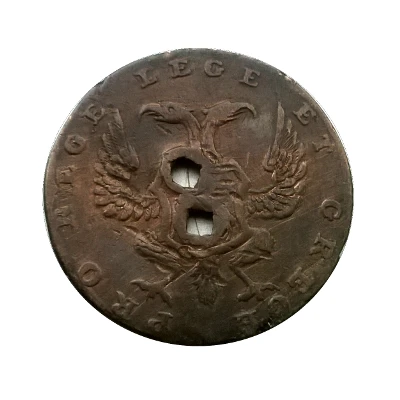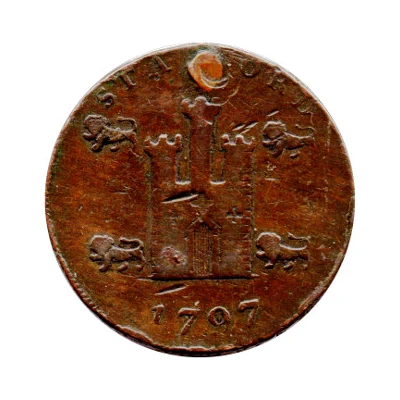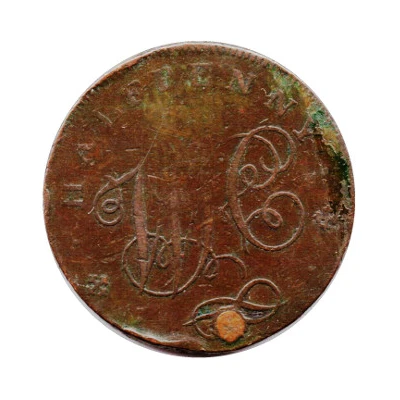


© ABC Coins & Tokens
½ Penny Angusshire - Dundee / Dudhope Castle
1797 year| Copper | 12.1 g | 29 mm |
| Issuer | United Kingdom (United Kingdom, British Overseas Territories and Crown Dependencies) |
|---|---|
| Type | Token |
| Year | 1797 |
| Value | ½ Penny (1⁄480) |
| Currency | Conder tokens (1787-1797) |
| Composition | Copper |
| Weight | 12.1 g |
| Diameter | 29 mm |
| Thickness | 1.5 mm |
| Shape | Round |
| Technique | Milled |
| Demonetized | 1797 |
| Updated | 2024-10-08 |
| Numista | N#90002 |
|---|---|
| Rarity index | 90% |
Reverse
Centre circle containing a man in a tail coat and a hat working at a hachel, or bench fitted with upright teeth, hackling flax. Behind him are two bales on the floor, marked "T.R." and "D.R.", representing the Tay and Dundee Roperies. Lettering above and below. Lettering outside circle, plain border
Script: Latin
Lettering:
3,336 TONS FLAX & HEMP IMPORTED HERE IN 1796.
VALUE · L.160,128 -*
FLAX-HECKLING
W: DES:
Engraver: William Wyon
Edge
Plain
Comment
Dudhope Castle was the home of John Graham of Claverhouse, also known as Viscount or "Bonnie" Dundee, who died leading the highlanders to victory in the battle of Killiecrankie. Below is a print of Dudhope Castle around the time of it's ownership by "Bonnie Dundee".Catalogue: D&H Angusshire No: 20.
Diesinker, Wyon; manufacturer, Kempson. One ton struck. Common. There are two minor variants - namely whether in 1794 date the 4 points to centre of second window, or it points between second and third window.
There were two rope making companies in Dundee, the Tay Ropery, and the Dundee Ropery, and it is conjectured that T.R. and D.R. stand for these firms. James Wright issued farthing pieces similarly marked, and therefore it is probable that he was also responsible for this halfpenny.
The designs suffer from Wright's idiosyncracies. There is far too much lettering, and the manner in which the 1794 has escaped out of the obverse exergue is very odd.
The ruins of Dudhope Castle stand on a hill about a mile from the old town of Dundee, and was the stronghold of the Scrymgeours, the Hereditary Constables of Dundee. Later the building was used as a woollen mill for a short time, and then was leased to the Crown for barracks, as mentioned in the legend.
Hackling is a process in the preparation of flax, when the filaments are teased into fine fibrils. The flax is watered and swingled and then the worker, as seen on the token, draws the strike of flax over the hatchel teeth, until the tow has been removed and the fibres lie in long parallel strands.
Interesting fact
One interesting fact about the Token ½ Penny (Angusshire - Dundee / Dudhope Castle) 1797 from United Kingdom is that it was issued during a time of severe currency shortages in Scotland, particularly in the eastern counties. The coin was minted by a private company, the Dundee Bank, to address the issue and was accepted as legal tender in the local area. Despite its small denomination, the coin was made of copper, which was a valuable material at the time, reflecting the scarcity of metals available for minting.



